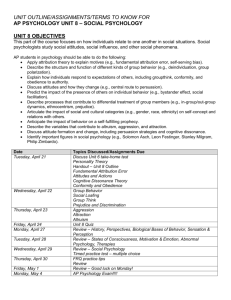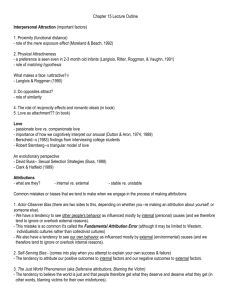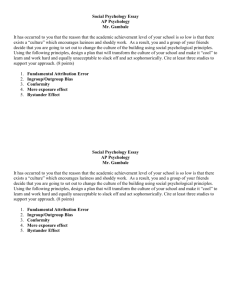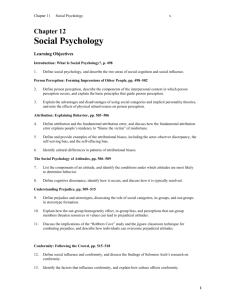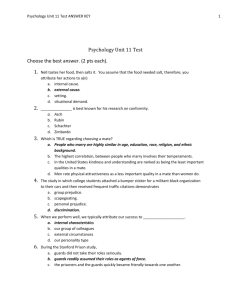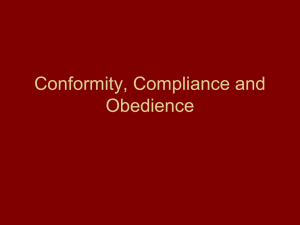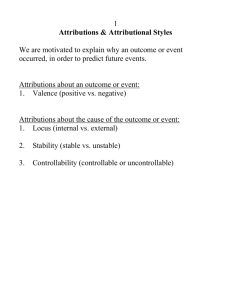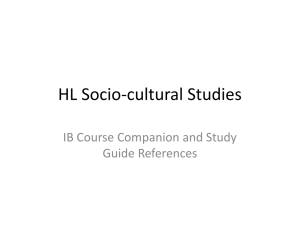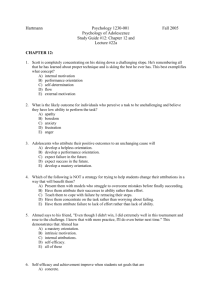File
advertisement
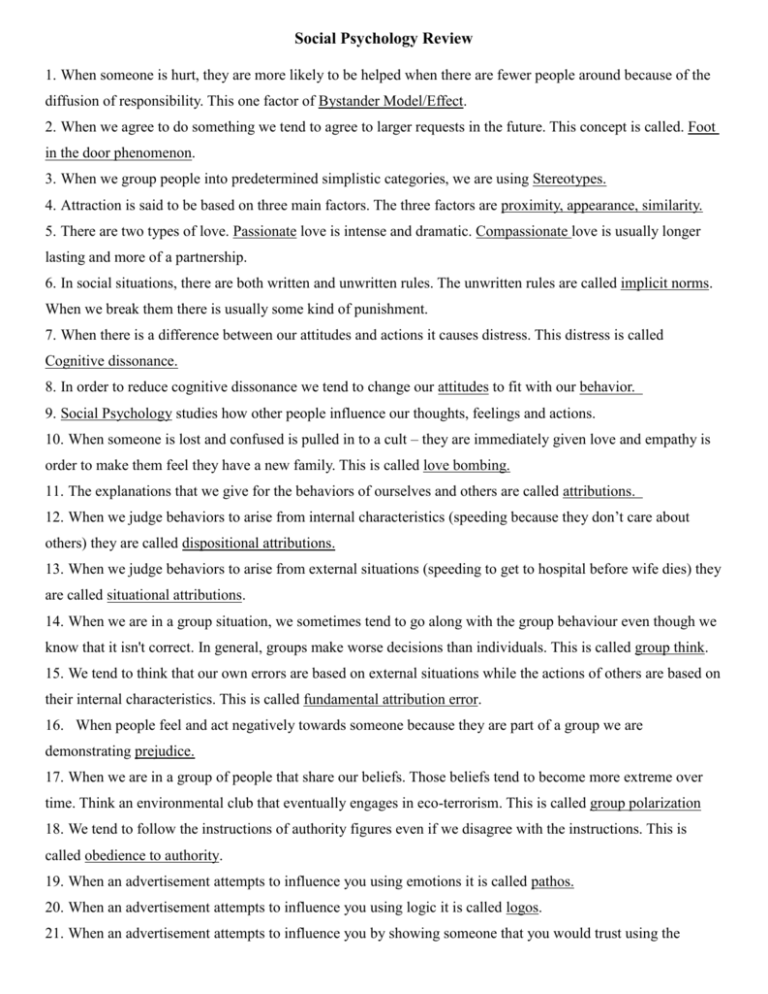
Social Psychology Review 1. When someone is hurt, they are more likely to be helped when there are fewer people around because of the diffusion of responsibility. This one factor of Bystander Model/Effect. 2. When we agree to do something we tend to agree to larger requests in the future. This concept is called. Foot in the door phenomenon. 3. When we group people into predetermined simplistic categories, we are using Stereotypes. 4. Attraction is said to be based on three main factors. The three factors are proximity, appearance, similarity. 5. There are two types of love. Passionate love is intense and dramatic. Compassionate love is usually longer lasting and more of a partnership. 6. In social situations, there are both written and unwritten rules. The unwritten rules are called implicit norms. When we break them there is usually some kind of punishment. 7. When there is a difference between our attitudes and actions it causes distress. This distress is called Cognitive dissonance. 8. In order to reduce cognitive dissonance we tend to change our attitudes to fit with our behavior. 9. Social Psychology studies how other people influence our thoughts, feelings and actions. 10. When someone is lost and confused is pulled in to a cult – they are immediately given love and empathy is order to make them feel they have a new family. This is called love bombing. 11. The explanations that we give for the behaviors of ourselves and others are called attributions. 12. When we judge behaviors to arise from internal characteristics (speeding because they don’t care about others) they are called dispositional attributions. 13. When we judge behaviors to arise from external situations (speeding to get to hospital before wife dies) they are called situational attributions. 14. When we are in a group situation, we sometimes tend to go along with the group behaviour even though we know that it isn't correct. In general, groups make worse decisions than individuals. This is called group think. 15. We tend to think that our own errors are based on external situations while the actions of others are based on their internal characteristics. This is called fundamental attribution error. 16. When people feel and act negatively towards someone because they are part of a group we are demonstrating prejudice. 17. When we are in a group of people that share our beliefs. Those beliefs tend to become more extreme over time. Think an environmental club that eventually engages in eco-terrorism. This is called group polarization 18. We tend to follow the instructions of authority figures even if we disagree with the instructions. This is called obedience to authority. 19. When an advertisement attempts to influence you using emotions it is called pathos. 20. When an advertisement attempts to influence you using logic it is called logos. 21. When an advertisement attempts to influence you by showing someone that you would trust using the product it is called ethos 22. In society, when something goes wrong we tend to try and find a group to take the blame for the situation. Think the Jewish people in Pre-WWII Germany. This is called scapegoat theory. 23. We tend to divide our lives into social circles. For example, at South Delta our friends would be an in group, while a rival group of friends would be an out group. 24. We sometimes make the mistake of believing that people “get what they deserve.” It is similar to the concept of Karma. In Social Psychology, this is called just world phenomenon. 25. In order to brainwash a person you need to break down their individuality and then replace it with group ideals. This is used to break individuality in cults. 26. The tendency to favor members of our In-group over other people is called in group bias. 27. This is a group that recruits people who are lost and confused. They then brainwash them and use them for hidden purposes or financial gain. Cult 28. Advertisers attempt to sell products by claiming that they are good for the “everyman.” What is this concept called in advertising? Plain folks 29. When an advertisement attempts to appeal to the upper echelon of society. Snob appeal 30. When everyone else is doing something, we tend to want to do it as well so that we do not stand out. This concept is called conformity. Long Answer: 1) Know and understand the factors that influence the Bystander Model 2) Be able to explain the cult & brainwashing process 3) Understand the 3 categories of advertisements and some specific techniques used in advertisements. 4) What are the two factors that influence conformity? Match the concept in social psychology with the example. Then explain how it is an example of the concept. Groupthink Obedience Bystander Effect Conformity Group Polarization Fundamental Attribution Error Cognitive Dissonance Attraction by Proximity Just World Phenomenon Ingroup Bias 1. Monica sees other people texting while driving and thinks to herself, "Jeez what jerks, they are selfish and endangering the lives of others. They're probably posting on Facebook or something.” When asked if she ever texts while driving, she says that she rarely does it and only in the case of emergencies when she must respond immediately. 2. Scott reads in the paper that a number of homes were flooded when some riverbanks overflowed. He thinks to himself that it was really their own fault. They were stupid for buying property so near a river. 3. Jeff hangs out with a group of friends. One day they are bored and they talk about whether they could get away with breaking into cars to steal change. Many members of the group of friends are uncomfortable with the idea but they decide to do it anyways. When they are caught by the police and questions, each group members says that they never would have decided to break into the cars individually. 4. Rebecca is approached by the principal of her school. The principal has heard that some students are cheating on tests. He asks her spy for him and find out who has been cheating on tests. Although she doesn't want to do it, she agrees to spy on her friends for the principal. 5. Steve arrives at school after summer vacation and sees that no one is wearing skate shoes anymore. All the students seem to be wearing running shoes. Even though he doesn't like wearing running shoes, he goes out and gets some because he doesn't want to stand out. 6. Chris and Kristine are in all the same classes in high school. They don’t really know each other and ignore each other for most of the year. They end up spending a lot of class time together and by the end of the year they are dating. 7. At summer camp a group of girls are divided up into teams to compete against one another. Over the course of the camp, the groups become really close and start to think of each other as friends. They also start to dislike the other group and to taunt and harass them. 8. Erica frequently has seizures. She had one in the hallway at school during lunch and it took a long time for someone to try and help her even though the hallway was full of students. When she had one at the dentist last week someone helped her right away. 9. At school, Mark joins an environmental club. The club is very casual at the beginning of the year, but it starts to get more intense and extreme as the year goes along. The group starts out talking about recycling but moves on to talking about egging cars that use large amounts of gasoline. 10. Sue believes that everyone should buy an electric car because they are better for the environment. When her car dies she looks into buying an electric car but is shocked at how expensive they are. She was really hoping to be able to go on a vacation but it looks like she would have to cancel her plans in order to get the car. She decides not to get the electric car and feels really guilty about it. She then changes her beliefs and decides that only people who are wealthy should choose to buy an electric car over a regular one.

